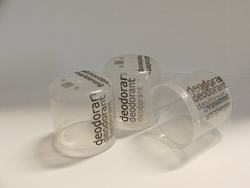Aug 29 2007
The marking and transmission welding of transparent plastics is an interesting subject which is of increasing importance for many plastic products.
Nowadays it is possible to achieve a good marking contrast in transparent and crystal clear plastics through the use of laser marking. The GABRIEL-CHEMIE Group offers a standard portfolio of tried and tested masterbatches with polymer specific carriers. Their competence centre for laser additives in Weitnau (GABRIEL-CHEMIE Deutschland GmbH) is equipped with lamp-pumped and diode-pumped Nd:YAG lasers (1064 nm) for the elaboration of recipes and for test marking finished articles.

The laser additive standard masterbatches have been designed for the 1064 nm wavelength utilised by the commonly used Nd:YAG lasers. A dosage of 2% initiates a new type of material effect. The thermal effects of the coupled NIR-light (NIR – near infra red) do not, as with previous additives, act directly on the surface of the plastic, but at a depth of between 20 and 300 µm.
This improves the marking quality in many aspects:
- The marking is substantially darker
- Surface roughening can be avoided
- The edge sharpness of the marked lines is increased
This improvement in quality means that applications in the area of design are also more easily possible, along with technical markings.
The most common applications and developments to date:
- Medicinal products, e.g. containers, syringes, cannulae, valves and many other applications made of PP and topas.
- Laboratory equipment: pre-numbered reaction tubes and microtiterplates made of PP.
- Frames for glasses made of transparent PA 12.
- Food packaging.
- Cover discs for displays made of PC or PS.
- Fluid level scales made of PP, PS, PMMA or PC.
- Disposable beverage containers made of SAN or PETG
- Light signals made of PMMA with blasted and therefore self lighting, light markings.
The additive and the use of polymer specific carriers ensure that clouding is avoided.
Carriers used include, for instance, polyolefins, PC, PET, transparent ABS, PS, SAN, COC, PMMA, SMMA and transparent polyamides.
Laser additives can also be formulated based on customer polymers, on request.
Laser transmission welding of plastics (LTW) is increasingly establishing itself as a welding technique, even for transparent or coloured transparent join partners. Gabriel-Chemie Deutschland offers specific masterbatches through customer specific projects.
The additive systems used for laser marking and laser welding are non-ionic, free from halogen, antimony and heavy metals and non toxic. They are suitable for use in items with food contact according to the German and European food regulations. Supporting data can be offered in order to gain medical approvals for finished articles. Laser sensitive masterbatches meet all the requirements regarding light and heat stability.
Due to the absence of colour, these additive systems can also be used in coloured, transparent plastics. They can be added in the form of combination masterbatches or as single components.